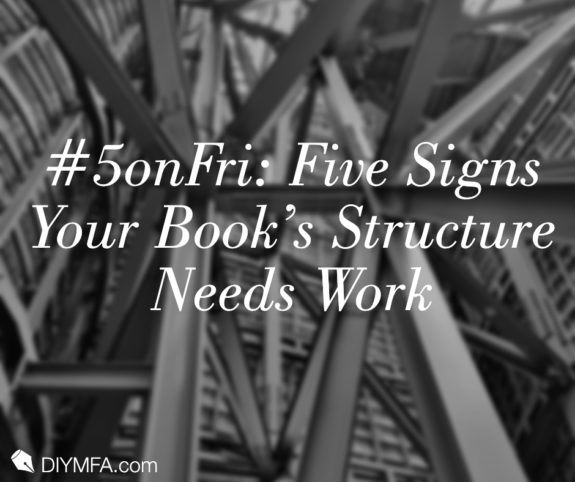Whether you’re a plotter or a pantser at heart, you probably recognize that an unwieldy, unclear, or unstable structure can be a death sentence for your novel. Even if you’re writing a book defined by its quirky characters or experimental style, most readers simply won’t have the patience to get through it unless the structure makes sense to them.
This doesn’t mean you have to lock yourself in a creative box. Great structure comes in many shapes and forms, and can emerge from plotters and pantsers alike! However, there are certain red flags that will crop up if your structure is less than optimal, and these are what you need to look out for — especially if you’re a first-time author.
Though I know it’s hard to appraise your work objectively, I implore you to look for these five signs that your book’s structure isn’t working, so you can fix it before readers realize the same thing. To help you identify them, I’ve included titles that I feel demonstrate these structural defects, at least to some extent; they’ll show you how even the most experienced authors can falter, and why we all need to be vigilant with our own work.
1) Your plot peaks too soon
Picture this: you’re a reader halfway through a novel. You know something big is coming, whether through foreshadowing, increasing tension, or open acknowledgement that a major event is about to occur. Then it happens — and as it turns out, the remainder of the book is more or less falling action. There’s nothing significant left to reveal to readers or change the fates of the characters; in other words, the plot has peaked far too soon.
It might sound easily avoidable, but this is a surprisingly common issue, especially among authors who don’t outline. And even for those who do outline, the compulsion to get to the “exciting part” may cause them to rush through the buildup, resulting in a climax that arrives many pages earlier than intended… and which often means filling the subsequent pages with drawn-out resolution or total fluff.
In my opinion, this is the essential structural flaw that undermines Elizabeth Gilbert’s recent novel City of Girls. (Spoilers ahead for this and all other books discussed here!) The plot follows a young woman named Vivian who gets involved in the sparkling show biz and social scenes of 1940s New York City. She’s surrounded by fascinating characters, ever-changing relationships, and potent drama, all of which makes for an excellent story.
However, about two-thirds of the way through the book, Vivian gets caught up in a scandal that forces her to leave her life of glamor behind. And while I know some readers found Vivian’s post-NYC existence interesting and narratively fulfilling, I was disappointed by the abandonment of the plot up to that point — especially once I realized nothing else was really going to happen.
If you suspect your book may suffer from this problem, think about how you might extend the buildup and/or the post-peak plot in a worthwhile manner. For example, Gone Girl has a major reveal in the middle that easily could have made the rest of the book seem lackluster! But Gillian Flynn ensures the story doesn’t end there, keeping readers hanging on with plenty of additional drama and satisfying twists.
2) You have too many threads to tie off
Another unfortunate structural issue is having too many character arcs, subplots, and other details you initially intend to be important, but which feel superfluous as you approach the end of your book. Fortunately, these threads aren’t hard to identify: if you’re wrapping up the main plot and you have more than one minor storyline still to resolve, you have too much going on.
There are two ways to handle this, structure-wise. The first is to simply remove the plot and character threads that don’t add anything substantial. For example, if you have a character who only appears a handful of times and doesn’t impact the plot, you can reduce or eliminate them entirely. (For authors with series aspirations, this may even be a blessing in disguise; a character you want to write more about, but who doesn’t have much bearing on the story you’re currently telling, could be perfect fodder for your next book.)
The second method is to try and resolve some of those minor threads earlier, so they don’t pile up and become overwhelming. This requires more thoughtful restructuring than scrapping whole subplots and characters, but it can be extremely rewarding, especially if the resolutions of those earlier threads contribute to the reader’s understanding of the “big” resolution later.
As for a concrete example of what not to do, you might look at some of Dickens’ works as having far too many threads. Of course, many would argue that this is exactly what makes Dickens great — the epic number of characters and subplots, the extreme level of detail. But, as I imagine anyone who’s read Bleak House would concede, a bit of pruning is sometimes necessary to make a book more comprehensible (and tolerable) for readers.
3) Your timeline jumps around too much
We’ve all read books with time jumps, and I won’t deny that flashbacks in particular are a great way to build narrative suspense. However, some time jumps can be more confusing than compelling, and may even cause readers to lose interest completely; this is why a jumpy timeline can be a sign that you need to restructure your book.
Continuing in my vein of controversial examples, Slaughterhouse-Five by Kurt Vonnegut is a quintessential case of too many time jumps. To be fair, the chaotic structure of this somewhat dystopian novel does accurately reflect the story — that of a man “unstuck in time” — and over the course of reading it, I’ll admit that I came to respect Vonnegut’s unorthodox approach.
However, I’ve since realized this is a case of the exception proving the rule. Even upon rereading the book, each time jump was still quite disorienting; I only remained invested and entertained because of Vonnegut’s immense skill as a writer. Needless to say, if Kurt Vonnegut can barely get away with this kind of time-jumping, the rest of us probably shouldn’t attempt it.
That said, if you find your story’s timeline jumps around too much (especially if you, the author, have trouble keeping track!) the best thing to do is go back to square one. What did you intend to accomplish with this structure, and might the same goals be attainable through fewer time jumps — and perhaps fewer perspectives, if that’s a complicating factor as well?
If you end up re-outlining your entire book, it might help to use a writing app to keep track of different elements. This way, even if you continue to use time jumps, you’ll have a clear visual sense of your chronology. (Scrivener 3 with Label View is the one I have in mind, but any writing tool with outlining functionality should greatly improve your use of time in a narrative.)
4) Your late-stage “revelations” are unsatisfying
This is perhaps the most irksome structural flaw I’ve come across as a reader, because it’s almost impossible to identify until you’ve read the book in full. In a way, it’s the opposite of the first issue I mentioned: rather than peaking too soon, the story builds and builds, dropping tantalizing hints and drawing out every bit of tension, and then… it fails to resolve in a satisfying way.
Sometimes the “big reveal” is glaringly obvious, or it’s not much of a reveal at all. Or sometimes a late-stage twist will arise with no foreshadowing whatsoever, which has the added “bonus” of making the reader frantically flip back through the book to scan for signs that were never there.
Whatever the form, it’s incredibly frustrating to invest so much time and energy in a book, only to be cheated out of a satisfying resolution. Once again, I speak from experience; I recently picked up Tangerine by Christine Mangan, a book claiming to be “The Girl on the Train meets The Talented Mr. Ripley.” High praise!
But despite an atmospheric start, Tangerine quickly devolves into a sort of suspenseful endurance test, doling out promising information without ever doing anything interesting with it. In the end, as one reviewer put it, “everything is exactly as it seems” — what’s perhaps intended to be a twist is just a slightly clearer iteration of information that was already provided.
Of course, to pinpoint this kind of structural problem in your own book, you have to be extremely honest with yourself. Consider your ending and what you’ve done to build to it. If there’s a reveal or dramatic ending of any kind, have you hinted at it without being too obvious? If there’s not, or if it’s intentionally out of left field, might readers feel that you led them on? Any doubts should prompt you to take another look at your structure, and potentially rework it for a more satisfying outcome, whatever that might mean for your readers. Speaking of which…
5) Your readers become confused
This is an undeniable catch-all for any author worried about their book’s structure: if other readers have trouble following it — even if it’s crystal-clear to you! — you have a problem. This could be due to any number of reasons, including any or all of the issues outlined above. But whatever the culprit, if a third-party reader tells you the structure doesn’t make sense to them, you’d better trust their objective opinion.
This is why, if you’re planning to publish your book, you should seek out beta readers and other trusted commentators to provide feedback as early as possible. Hire a professional editor if you have to; just get some eyes on your book that aren’t your own.
And even if they tell you to burn everything and start over, that’s still much better than releasing a book with a structure no one can understand. Plus, the next time you write a book, you’ll know exactly what tends to go wrong with your structure… which some might say is the first step toward making sure everything goes right.

Savannah Cordova is a writer with Reedsy, a marketplace that connects authors and publishers with the world’s best editors, designers, and marketers. In her spare time, Savannah enjoys reading contemporary fiction and writing short stories.







